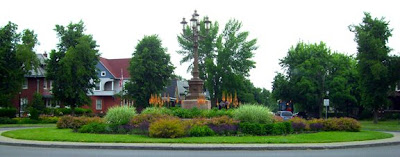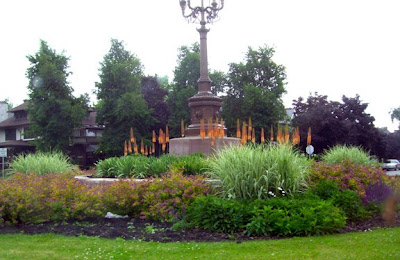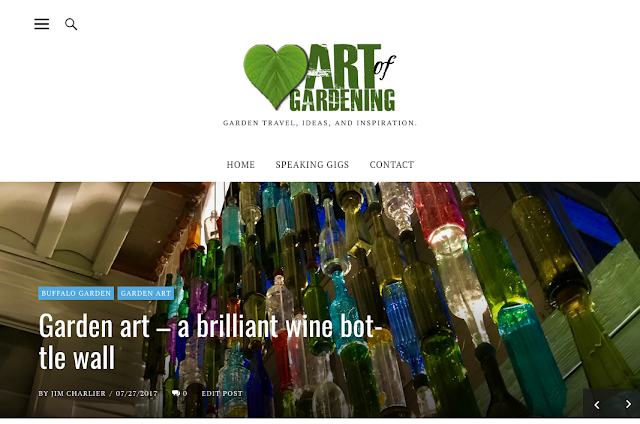Traffic Circle #2–Another Round

Buffalo is blessed with an urban landscape designed by none other than Frederic Law Olmsted, inspired in large part by the parkland, boulevards, and squares of Paris. Our system of parks, parkways and traffic circles make up one of his largest bodies of work (completed around 1896).
 From any direction, this circle makes for a pleasing substitute for the former asphalt runway this intersection was when I came to Buffalo in 1980.
From any direction, this circle makes for a pleasing substitute for the former asphalt runway this intersection was when I came to Buffalo in 1980.One of the most compelling aspects of the parkways are the traffic circles incorporated into many of our neighborhoods. Last post on a traffic circle I did was Gates Circle, the traffic circle at the end of my street. This time, I chose Ferry Circle at the intersection of Richmond Avenue & West Ferry Street, 'cause it looks particularly nice this time of year.
 The original circle was much smaller. The circa 1909 light standard, probably gas fed, was taken away in the 1930s. The 6,500 lb. reproduction, a twin to the light standard in Symphony Circle, the traffic circle just up the street, was installed in 2002.
The original circle was much smaller. The circa 1909 light standard, probably gas fed, was taken away in the 1930s. The 6,500 lb. reproduction, a twin to the light standard in Symphony Circle, the traffic circle just up the street, was installed in 2002.The original circle on this site was built around 1870 (accommodating horse & carriage traffic) In 1920, it looked like the photo to the left. In the 1930s it was completely paved over. In 1980, when I came to Buffalo, it was just a huge intersection with insufferable red lights and a congestion-causer. There was nothing in the center of the intersection–just a huge expanse of asphalt pedestrians feared to cross. My old house was not too far from this circle and I drove around it nearly every day. The new circle is a vast aesthetic improvement over the past intersection.
In 2002, ground was broke to remake a circle, including an exact replica of the light standard that was originally there. Partners in this resurrection were the City of Buffalo, Erie County, Olmsted Parks Conservancy, Richmond Neighborhood Association, the Symphony Circle Steering Committee, Kleinhans Community Association, Colgate Industries, and the Rupp Foundation.
Olmsted's idea of the circles and parkways was to serve as a means for a visitor to travel from one park to another (Delaware, Cazenovia, Front, South Park, Riverside, and Martin Luther King, Jr. parks) without leaving the park setting, as well as extending the parks into the city.
 Wish a plant list existed for the circle. Others could benefit from its design.
Wish a plant list existed for the circle. Others could benefit from its design.The circle's gardens had the soil replaced, compost, organic fertilizers and mulch were added. Grass areas were aerated and mowed at a higher level than would normally be done. A drip irrigation system was installed. Herbaceous and woody perennials were planted to improve soil and reduce water runoff.
One thing sadly lacking on the otherwise insightful Olmsted Conservancy website is a complete plant list of what is planted in the circle.
I know many hate circles because they can be tough to navigate if you're unfamiliar with the rules (PEOPLE IN THE CIRCLE HAVE THE RIGHT OF WAY!!!). But I love them for their traffic-calming (you have to slow down as you approach), and the lack of traffic lights (traffic flows better).
My big compliant with this circle is that there are stop signs all around. They should ideally be yield signs. Traffic circles don't need stop signs to work well–and actually keep traffic halting by using the stop signs. Another problem with this traffic circle is that nearby traffic circles, both larger and smaller, have yield signs. The inconsistent use of yield or stop signs in our circles, I think, just leads to more confusion.







You are right this is lovely. Thank you for showing us.
ReplyDeleteBest wishes Sylvia (England)
Thank you. Very informative post.
ReplyDeleteI wonder if I could get the town of Amherst to foot the bill for my cul-de-sac, I know they give us compost for free. I wonder where that comes from....Hummm.
Just another compelling reason to come to Buffalo next summer...
ReplyDeletebeautiful, things like this turn places full houses into communities of people with homes...as you said a calming effect
ReplyDeleteSylvia,
ReplyDeleteHigh praise from a resident of the country of round-abouts!
Claudia,
hey, I've taken advantage of the Amherst compost. Back when we had access to a truck me and a friend from Amherst would go out and get a truck-full each spring.
Susan,
Would you like your wings prepared in mild, medium, hot or suicidal?
B&G Girl,
These are neighborhood landmarks as well.
That's probably one of the most beautiful traffic circles I've ever seen, and I've seen a lot of them in Britain! Thanks for sharing.
ReplyDeleteThe eremurus are the best feature of that circle. I did not realize they were up; I've been looking for them.
ReplyDeleteAmazing!
ReplyDeleteJim - good point about the Yield signs - the whole point of roundabouts (as we call them here in the UK) is to keep the traffic flowing. Studies have shown that Stop signs makes things worse.
ReplyDeleteSylvia (England) pointed me in your direction. I'm doing a whole series on public planting this year and every quarter I'm getting everyone to show public planting in their neighbourhood or whatever post on the topic people would like to share with us.
Naturally, roundabouts have featured already, but nothing as spectacular as this one.
Do you mind if I put a link in to your post on my Out on the Streets (as I'm calling it) kick off post and tell everyone about it in my June wrap-up post next week?
VP,
ReplyDeleteLink away! Feel free to link up. I'm complimented you should think this post worthy. FRom what I've gathered, the circle includes spirea, eremurus, zebra grass and salvia, among other plants.
Hi Jim - done, linked and posted :)
ReplyDeleteCool post you got here. I'd like to read something more concerning that topic. Thank you for posting that info.
ReplyDeleteSexy Lady
English escorts